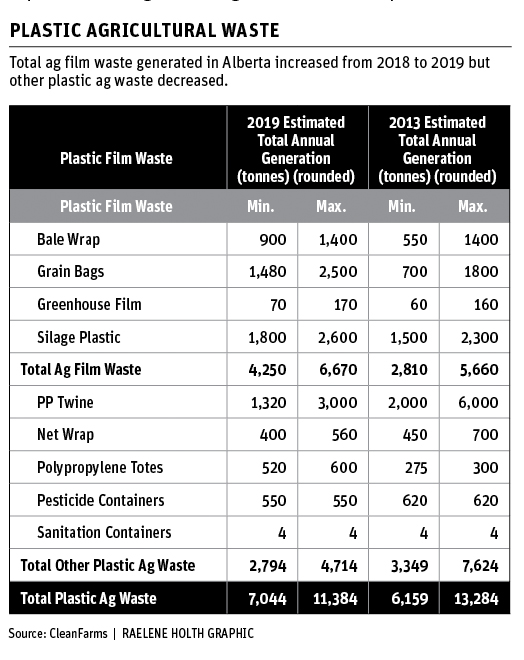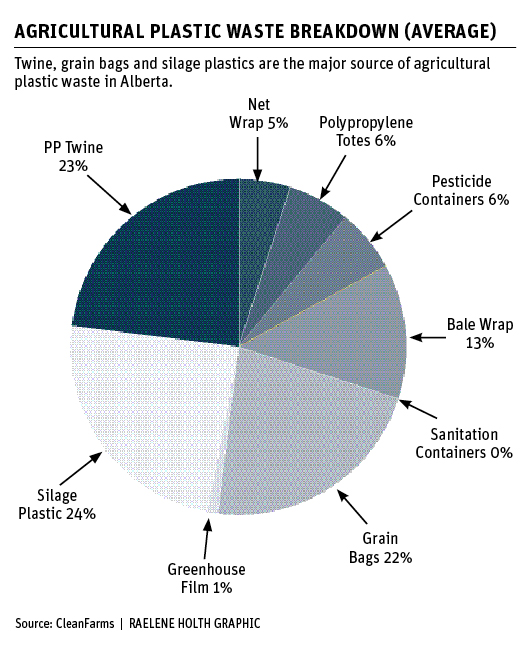A farmer survey found 69 percent of grain bag users and 72 percent of twine users said it is hard to recycle the items
Plastics play a major role in farm supply needs, from grain bags to bale wrap and twine.
An Alberta analysis of waste plastic, completed this fall, estimates total agricultural plastic waste in the province in 2019 to be somewhere between 7,044 and 11,384 tonnes.
A survey of 428 Alberta crop and livestock producers carried out earlier this fall was designed to gauge practice and attitudes toward plastics and recycling. It also attempted to quantify plastic waste to determine the need and demand for recycling projects and measures.
A pilot project organized through CleanFarms and the Alberta Plastic Recycling Group, running until 2022, is now underway to collect grain bags, twine or both at 20 Alberta sites. A market study showed that grain bags and twine represent 50 percent of all waste plastics generated on Alberta farms. The other half is bale wrap and silage plastic, netting, supersacks, greenhouse film and high-density polyethylene containers.
Read Also

Farming Smarter receives financial boost from Alberta government for potato research
Farming Smarter near Lethbridge got a boost to its research equipment, thanks to the Alberta government’s increase in funding for research associations.
The start of bag and twine collection is actually the third part of the pilot process, said Tammy Schwass, executive director of the APRG.
The first part was the farmer survey of plastic type and use on farms. The second part was a CleanFarms-initiated study about markets for plastics once collected. That became more problematic in 2018 when markets in China and Malaysia stopped accepted North America’s used plastic for recycling. Until that point, China alone was handling 56 percent of the world’s plastic scrap.

Establishing collection sites was the third piece in the pilot process, with 20 either established or soon to be ready, said Schwass.
The farmer survey showed 69 percent of grain bag users and 72 percent of twine users said it is either somewhat or very difficult to recycle those items. Some 32 percent of grain bag users return them for recycling and 24 percent take them to the landfill. The remainder said they store the bags to deal with later.
As for twine, 46 percent of respon dents said they burn it, 28 percent use a landfill and only 13 percent return it for recycling.
The survey showed 92 percent of grain bag users and 86 percent of twine users were very or somewhat likely to participate in the pilot for collection if there is a site in their area.
“What really gives us a lift is how ready producers are to incorporate recycling and safe disposal programs into their operations,” said Kim Timmer, manager of stakeholder relations with CleanFarms.
“Right now the survey results give us a really good snapshot of how producers are managing their grain bags and twine when they no longer need them. Our challenge really is to make sure we put sites around the province and we give as many producers the opportunity to recycle” as possible.
Other survey results include:
- Seventy-seven percent of producers are very/somewhat concerned about how to deal with ag plastics.
- Ninety-two percent said recycling ag plastics is very/somewhat important to them.
- Eighty-three percent said if a program is easy and convenient, it’s a good alternative to ag plastic waste disposal.
- Among those who recycle, 94 percent of twine users and 81 percent of grain bag users said they were satisfied with the method.
- Fifty-eight percent agree that users of grain bags and twine should contribute to the cost of a recycling program.
- Eighty-two percent agreed that although there is a need for a program, they didn’t like additional costs it might entail.
- Fifty percent are opposed to paying an environmental handling fee.
In the executive summary of CleanFarms’ market analysis report, it noted ag plastics are challenging to recycle because of contamination and because various types used on the farm are often mixed together and can’t be sorted efficiently.
It said there are two grain bag recycling facilities in North America — one in Canada and one in the United States — and another is being built in Western Canada. The material is washed and pelletized for use in plastic mould applications.
Two U.S. facilities recycle polypropylene twine, which is either pelletized for remanufacture or shredded for the roofing industry.
Shane Hedderson, western region business manager for CleanFarms, said the market for grain bags is strong despite a recyclable plastics glut caused by closure of the Chinese and Southeast Asian markets.
“You have grain bags that are sort of up at the top of the list because they’re thick, they’re heavy, their use generally doesn’t mean that they’re heavily contaminated like some of the other ag film products,” he said.
“When we’re dealing with grain bags in Alberta, it’s actually one of the highest quality ag films, which makes it easier to find markets.”
 As for twine, “the prices are much lower than they used to be because of the oversupply in the market, but as these new facilities and infrastructure continue to be built within North America … to recycle this stuff, those prices should start to normalize as the oversupply situation dries up.”
As for twine, “the prices are much lower than they used to be because of the oversupply in the market, but as these new facilities and infrastructure continue to be built within North America … to recycle this stuff, those prices should start to normalize as the oversupply situation dries up.”
Hedderson said he expects international markets for recyclable plastics, including ag plastics, will reopen in the future though perhaps not as many as there were before.
Market closure was due in part to the number of illegal overseas operations. In Malaysia, for example, the government has shut down more than 170 illegal recycling operations, leaving only 36 that are properly permitted, Hedderson said.
CleanFarms was using one of those 36 in the past, having done its due diligence, he added.
“Our end markets are very, very important. We want to make sure that these products are being managed properly, and the material is being recycled and not just dumped and buried.
“The most important part is to make sure that we’re not contributing to additional problems by using illegal recyclers and that sort of thing.”
However, Hedderson said ideally Canadian ag plastics could be recycled in Canada or at least North America.
“We obviously want to keep everything in Canada just from an economic standpoint. It’s much cheaper to transport grain bags from Alberta to a recycler in Alberta versus overseas, but we’re hoping that as these (overseas) markets start to sort themselves out, the most economically feasible action, and socially responsible option, will be presented to us.”
Information on Alberta collection sites for grain bags and twine can be found at cleanfarms.ca/alberta-ag-plastic-recycle-it-program-details/#collection-sites.


















